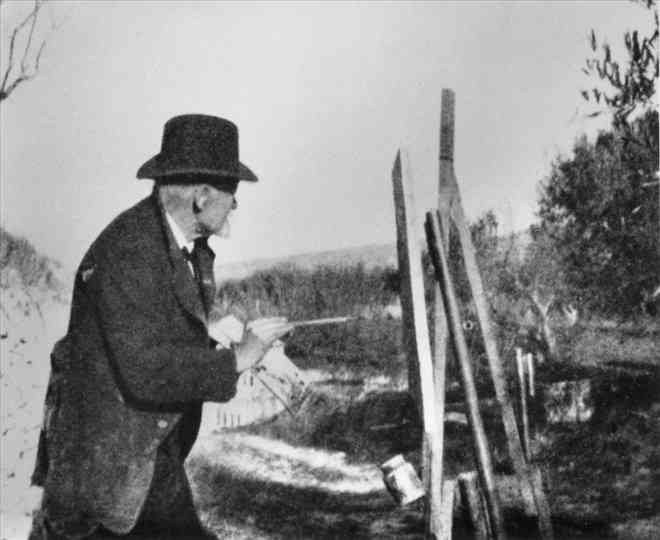Hat sat on his head, eyes glued to the far horizon of Provence, palette and brush motionless. The man was then 63 years old. In the twilight years of the search that began half a century ago, he waited anxiously. His name is Paul Cézanne; he is Paul Cézanne painting the motif, here captured by artist Ker-Xavier Roussel.
Paul Cézanne painted motifs in Aix-en-Provence. Photo by Ker-Xavier Roussel.
An artist who is despised by his contemporaries but still perseveres in solitude moves people more than anything else. “A painter like him only comes once every two centuries.” The confusing statement adds to the appeal of this outstanding artist, who has captivated generations until now!
From a long period of anonymity to being honoured worldwide
Rarely does any artist have a career that starts as pitiful as this artist. In his journey searching for recognition, he wanted to become “the painted-nature Poussin” (Nicolas Poussin (1594 – 1665), a French master of painting in the Baroque style. Poussin’s works often drew on religion and deity themes, while Cézanne focused more on the nature aspect). He wanted to give Impressionism the solidity of “museum art.” The little honour given to the artist at the end of his career does not make us forget the injustice he endured for a long time, which became even more severe because, after his death, he was honoured suddenly. Artist Jean Lurcat summarized it simply like this in 1932: “During his lifetime, he was aggressed, but rarely were artists aggressed like that; the government did not know about it, and the press constantly insulted him. Then, 10 years after his death, Cézanne held the leading position in the entire world painting industry.”
In a time when the market regulates contemporary art tastes, prices for Cézanne’s works can make people dizzy: In February 2012, one of five versions of “The Card Players” (Joueurs de cartes) was sold to the Qatari Royal Family for $250 million. The number was even more astonishing when we consider that, unlike some contemporary artists who were into financial investing, Cézanne was registered at the pinnacle of art history and therefore could not interfere with financial aspects to increase his works’ values. Even more meaningfully, his name has been chosen by the University of Aix-en-Provence to name the school since 2005, the ultimate testament to his true glory, which can only come from the recognition of a genius, though delayed but inevitable.
Cézanne’s art
In addition, few artists are so widely known around the world. About a thousand oil paintings and hundreds of watercolours by Cézanne are displayed on five continents, bringing honour to museums and prestigious private collections from Paris to Chicago, from Moscow to London, and from São Paulo to New York. The artistic value of those works is unparalleled; sensitive souls find in them the complete expression of a classical genius in the synthesis of many characteristics and parameters: the power of form, characteristic Mediterranean lyricism, absolute precision, courtly elegance, universal tendency, and mastery in the pursuit of innovative ideas. A perfect art.
Taking inspiration in composition from Poussin, Véronèse, or Chardin, borrowing chromatic expression from Rubens or Delacroix, subjective realism from Courbet, and lighting effects from Impressionist painters, Cézanne stands out first of all by his keen eye, colour range, and chroma, factors that led him to an extremely important discovery: how to express light and shape with just a single color. This technique has a double effect: fragmentation of the shapes—each piece is shaped freely—and geometrization of the forms. Having broken its stability, the surface of the painting suddenly vibrated and took on a disturbing breath, not unlike a scene stirred by heat. And the geometrization of motifs, in which the specificity is erased so that the motifs blend into the general shape, emphasises the fundamental autonomy of the image that characterises Cézanne’s painting.
This autonomy bypasses visual arbitrariness—abandons the single point of view and uniform colour, seeks the core rather than the line—and imposes a complete break with the painting style that the period Quattrocento passage once defined.
In that direction, Cézanne’s influence on the twentieth century is limitless. To this day, the lonely and doubtful prophet Paul Cézanne still has a great influence on many artists, but was it not Rainer Maria Rilke, with her sharp intuition, who did not hesitate to glorify Cézanne’s brilliant universe is the universe “beyond the bounds of the perishable”?
A tribute from Picasso
Is there any art lover who cannot recognise Paul Cézanne’s paintings at first glance? The famous series of still-life paintings with apples and oranges, bathers, or views of Sainte-Victoire Mountain not only made their mark in the history of 19th-century art but also fascinates modern visitors to museums around the world.
Calling himself “a pioneer of new art,” Paul Cézanne joined the ranks of the most influential artists beyond the theories of Impressionism. Art historians even consider him one of the fathers of modern art. “He is the father of us all”! is a short saying, but coming from Pablo Picasso, the symbol of modern painting and the most famous artist of the century he lived in, it is valuable as a declaration for the posterity of this Aix artist. The great Spaniard confided so to photographer Brassa, adding that he always recognised Cézanne alone as “the one and only master”. However, it seems that Picasso did not meet Cézanne and did not even try to correspond with him even once. From the first time they stayed in Paris, all the artists told Picasso about the lonely prophet’s retreat to Provence, and when he moved to the French capital in 1904, Picasso could have gone to Aix at will, like everyone else around him. Even more strangely, he never tried to adapt Cézanne’s work, as he brilliantly adapted Manet’s “Luncheon on the Grass” (Déjeuner sur l’herbe), the painting “The Maid” (les Ménines) by Vélasquez, or “Women of Algiers” (Femmes d’Alger) by Delacroix. Finally, many Picasso biographers have fondly noted that, in the final years of his life, Picasso purchased the simple but beautiful Vauvenargues castle at the foot of Mount Sainte-Victoire, which may have been a touching tribute he reserved for his senior. And Picasso was certainly not just joking when he told his dealer, Henry Kahnweiler, that he had just bought “Mount Sainte-Victoire,” not one of several hundred Cézanne paintings that used this peak as its subject… but the “original”!
In the book Paul Cézanne, Denizeau analysed a rich number of masterpieces, thereby portraying the genius painter with a genuine strength, a Mediterranean lyricism, a strict discipline, a discreet elegance, and a masterful creative will.
Source: Laodong magazine / Au: TRẦN THẾ VINH / Translate: K.Uyen



